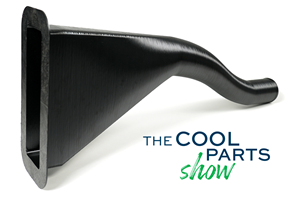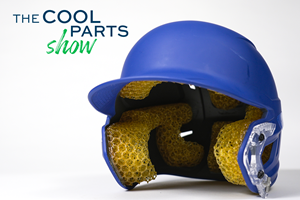EOS Helps Strengthen Indiana Tech's STEM Program
Indiana Tech acquires second EOS additive manufacturing system as part of a $21.5 million expansion of its Zollner Engineering Center and STEM educational programming.
EOS M 290 system at Indiana Tech Talwar College of Engineering and Computer Sciences. Photo Credit: EOS
Indiana Tech has acquired its second EOS industrial 3D printer, the Formiga P 110 Velocis, as part of its engineering center expansion and renovation for the Talwar College of Engineering and Computer Sciences program. The polymer selective laser sintering (SLS) 3D printer complements Indiana Tech’s prior investment of its EOS M 290 Direct Metal Laser Sintering (DMLS) metal 3D printer in September 2022, as a tool for its biomedical and advanced manufacturing programming, and new additive manufacturing (AM) certificate.
The university began acquiring AM technology as part of its large $21.5 million expansion and renovation of the Zollner Engineering Center, increasing educational access to state-of-the-art engineering training and equipment within the university’s Talwar College of Engineering and Computer Sciences programs. The expansion is set to be complete in October 2023, nearly doubling the size from its previous structure.
Indiana Tech plans to provide a unique advantage to engineering students with the purchase of EOS’ technology, making it one of the only universities in Indiana to provide access to both polymer and metal AM technology. As the Talwar College of Engineering and Computer Sciences expands, Indiana Tech plans to increase AM educational offerings and programming for incoming students.
“3D printing will have a massive impact on advanced manufacturing by decentralizing production, improving product customization and resource efficiency, and reducing complexity,” says Dr. Ying Shang, Indiana Tech’s dean of the Talwar College of Engineering and Computer Sciences. “As northeast Indiana grows its advanced manufacturing potential, the region’s workforce will need new knowledge and skillsets in additive manufacturing. With the two new additions of innovative EOS 3D printers and additional 3D printers for carbon fiber and other composite materials, Indiana Tech will become the leading institution in the nation for developing new talent in additive manufacturing for automotive, medical device, aeronautical applications and more.”
The purchase of the EOS M 290 and Formiga P 110 Velocis systems were made possible, in part, by support from a private alumni donor and the university’s grant awards, specifically the U.S. Department of Commerce’s Economic Development Administration (EDA) $1.5 million grant to support workforce training efforts. The EDA funding is a part of the American Rescue Plan Economic Adjustment Assistance program, expected to create 700 jobs and retain 100 as a direct result of purchasing technical equipment, such as EOS AM systems.
“As additive manufacturing begins to play a larger role in U.S. manufacturing, it is crucial we prepare the next generation of STEM for the shift in engineer training,” says Greg Hayes, senior vice president of applied technology at EOS North America. “Amid ongoing AM adoption and government investment into the technology, we feel confident that use of our printers will give Indiana Tech students the tools and competitive advantage needed to bolster the workforce and push the boundaries of what we can accomplish with industrial 3D printing.”
- Check out this article on EOS working with nTop to create file capability to limit design data bottlenecks. EOS and nTop have created a new nTop Implicit File that can result in up to 99% smaller file sizes, 500 times faster file generation and 60% faster load time, making it more readily available to additive manufacturing build preparation software for manufacturing.
- Learn about EOS’ sustainable polymers for additive manufacturing. The climate-neutral PA 1101 and carbon-reduced PA 2200 polymer materials are designed to increase production efficiency, while supporting more sustainable additive manufacturing.
Related Content
Aircraft Ducts 3D Printed in Composite Instead of Metal: The Cool Parts Show #68
Eaton’s new reinforced PEKK, tailored to aircraft applications, provides a cheaper and faster way to make ducts compared to formed aluminum.
Read More3D Printed Lattices Replace Foam for Customized Helmet Padding: The Cool Parts Show #62
“Digital materials” resulting from engineered flexible polymer structures made through additive manufacturing are tunable to the application and can be tailored to the head of the wearer.
Read More3D Printed Spine Implants Made From PEEK Now in Production
Medical device manufacturer Curiteva is producing two families of spinal implants using a proprietary process for 3D printing porous polyether ether ketone (PEEK).
Read More3D Printing with Plastic Pellets – What You Need to Know
A few 3D printers today are capable of working directly with resin pellets for feedstock. That brings extreme flexibility in material options, but also requires greater knowledge of how to best process any given resin. Here’s how FGF machine maker JuggerBot 3D addresses both the printing technology and the process know-how.
Read MoreRead Next
3D Printed Polymer EOAT Increases Safety of Cobots
Contract manufacturer Anubis 3D applies polymer 3D printing processes to manufacture cobot tooling that is lightweight, smooth and safer for human interaction.
Read MoreAlquist 3D Looks Toward a Carbon-Sequestering Future with 3D Printed Infrastructure
The Colorado startup aims to reduce the carbon footprint of new buildings, homes and city infrastructure with robotic 3D printing and a specialized geopolymer material.
Read MoreCrushable Lattices: The Lightweight Structures That Will Protect an Interplanetary Payload
NASA uses laser powder bed fusion plus chemical etching to create the lattice forms engineered to keep Mars rocks safe during a crash landing on Earth.
Read More





















